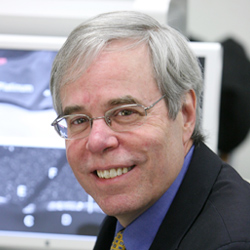Northwestern Experiments Head to Space
Two professors receive NASA funding to put experiments on the International Space Station
Two Northwestern Engineering experiments will soon take up residence inside of a galactic laboratory.
 NASA’s Physical Science Research Program is funding 16 flight proposals for research to be conducted aboard the International Space Station as a part of its MaterialsLab program. David Dunand and Peter Voorhees, both professors of materials science and engineering in Northwestern’s McCormick School of Engineering, are among those funded.
NASA’s Physical Science Research Program is funding 16 flight proposals for research to be conducted aboard the International Space Station as a part of its MaterialsLab program. David Dunand and Peter Voorhees, both professors of materials science and engineering in Northwestern’s McCormick School of Engineering, are among those funded.
“This is exciting news for Northwestern Engineering,” said Dunand, James N. and Margie M. Krebs Professor of Materials Science and Engineering. “Only sixteen projects were selected nationwide from a very large pool, and we received two of them.”
The NASA program funds projects that investigate physical phenomena in the absence of gravity. These projects both contribute to the basic understanding underlying space exploration technologies and lead to new, improved products for Earth.
 Dunand and Voorhees co-advise a project that creates foams made of titanium oxide and other ceramics through a process called freeze casting. When titanium oxide nanoparticles are suspended in water and frozen, the ice crystals push the nanoparticles into regions where they are concentrated. The ice crystals are then removed by sublimation, leaving behind a highly porous nanoparticle scaffold, which can be further consolidated by heat treatment.
Dunand and Voorhees co-advise a project that creates foams made of titanium oxide and other ceramics through a process called freeze casting. When titanium oxide nanoparticles are suspended in water and frozen, the ice crystals push the nanoparticles into regions where they are concentrated. The ice crystals are then removed by sublimation, leaving behind a highly porous nanoparticle scaffold, which can be further consolidated by heat treatment.
The freeze casting process benefits from zero gravity as the resulting structures are more regular than those created in the laboratory. Led by undergraduate Kristen Scotti, the Northwestern team has already performed this experiment on parabolic flights aboard NASA’s “Weightless Wonder” aircraft and will soon conduct it in a CubeSat, designed and built at Northwestern and the University of Illinois at Urbana-Champaign, which will be launched into low-Earth orbit next year.
Voorhees’ funded experiment will examine fragmentation that occurs during the solidification of a metal. Fragments are one of the major defects in metal castings and, for example, can greatly reduce mechanical properties of turbine blades used in jet turbines and wind turbines. Performing the experiments in reduced gravity prevents fragments from settling, making it possible to measure the location and rate at which these fragments form.
“This will help us understand the fragmentation process and build models to predict when these fragments may form during solidification on Earth,” said Voorhees, Frank C. Engelhart Professor of Materials Science and Engineering. “These models can then be used to prevent fragmentation during solidification of turbine blades and other castings on Earth.”